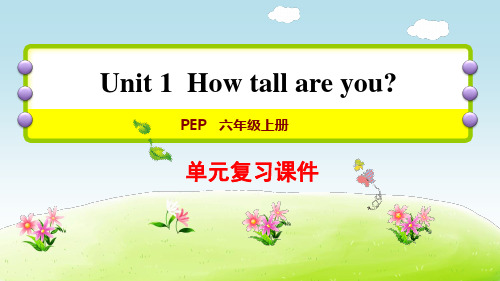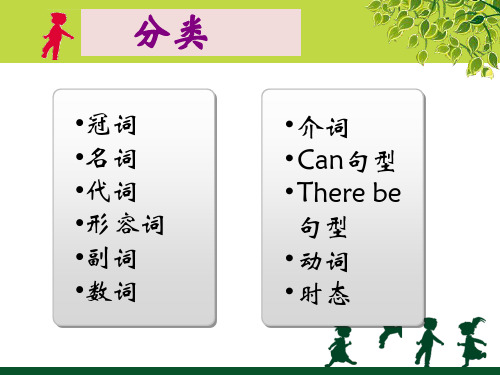人教版小学英语六年级毕业动词复习课件
小学六年级英语语法总复习PPT课件

• 小学阶段不规则动词全表
• Infinitive Past tense Infinitive
• 1. am, is
was
2. keep
• 3.are
were
5. make made
4.become
7. blow
blew
8. read
• 9. buy
bought
10. ride
• 11. catch caught
fly-flying walk-walking
jump-jumping sleep-sleeping
climb-climbing fight-fighting
swing-swinging drink-drinking catch-catching pick-picking
watch-watching play-playing
dance danced
变y为 i+ed
study studied
动词的过去式(不规则)
go-went read-read eat-ate sing-sang take-took buy-bought see-saw swim-swam am,is-was do-did are-were have-had get-got leave-left fly-flew stop-stopped(双写)
.
• 一般现在时的变化
1. be动词的变化。
否定句:主语+ be + not +其它。 如:He is not a worker.他不是工人 一般疑问句:Be +主语+其它。 如:-Are you a student? -Yes. I am. / No, I‘m not. 特殊疑问句:疑问词+一般疑问句。如:Where is my bike?
小学六年级英语语法复习ppt课件

.
.
.
.
• 写出下列各词的复数 I _________him _________this ___________her ______ watch _______child _______photo ________diary ______
man______ woman_______ paper_______ juice___________ water________ milk________ rice__________ tea__________
.
• 2.行为动词:主语+行为动词(+其它)。如: We study English.我们学习英语。 当主语为第三人称单数(he, she,it)
时,要在动词后加"-s"或"-es"。如: Mary likes Chinese.玛丽喜欢汉语。
.
• 二、用括号内动词的适当形式填空。 1. He often ________(have) dinner at home. 2. Daniel and Tommy _______(be) in Class One. 3. We _______(not watch) TV on Monday. 4. Nick _______(not go) to the zoo on Sunday. 5. ______ they ________(like) the World Cup?
• 6, 用在序数词,方位词前和形容词最高级前, the first , the east, the tallest
.
• 3、零冠词(不用定冠词) (1)名词前已有作定语用的this, that, these, those, my, your, his, her, our, their, some等限 定词时,不用冠词。如:this eraser, her pencilbox, some boxes, those women等。 (2)泛指的不可数名词前一般不用冠词。如:meat, rice, water, bread, tea, milk, juice等。 (3)复数名词表示泛指时,不用冠词。如: the people in the room are doctors. 房间里的那 些人是医生。 (4)在表示学科的名词前一般不用冠词。如: Chinese, English, math, physics, history等。在 三餐饭和球类运动名词前一般不加冠词。如:have breakfast/ lunch/ supper, play basketball/ football等。 (5)在季节、节日、星期、月份前不用冠词。如: autumn, summer, winter, spring, Teachers’ day, Children’s day, Sunday, February等。 (6)在表颜色、语种和国家名词前不用冠词。如: white, brown, French, Australia等。 (7)在表示称呼语的名词之前,以及职务、头衔的 名词前不用冠词。如:Docto.r green is a scientist. 格林博士是位科学家。
PEP人教版小学英语六年级下册期末复习课件(全册)

更小的 __s_m_a_l_l_er__ 12岁_1_2__y_e_a_r_s_o_ld__ 多重__h_o_w__h_e_a_v_y__
更强壮的__st_r_o_n_g_e_r 多高__h_o_w__t_a_l_l __ 多少号__w_h_a_t__si_z_e_
任务二:翻译重点句型 (两人一组,正确读出句子并翻译成汉语可得2分)
游戏规则: 按要求每完成一项任务即可获得相应的 分数,满10分即可获得一张王牌。
任务一:在习题本上写出下列单词或词组的过去 式并翻译成汉语,全部正确可得2分。
go_____w_e_n_t__去_______ ride__ro_d_e__骑__(__马__;__自__行__车__)_ hurt_h_u_r_t__(__使__)__受__伤__ eat_____a_te__吃_________ take ___t_o_o_k___拍__照_____ buy___b_o_u_g_h_t___买______ fall____fe_l_l__摔__倒_______ laugh____la_u_g_h_e_d___笑____
beautiful—more beautiful—most beautiful
任务四:看例子,说语法,学解题 (听老师讲例句,然后做下一页习题,全对可得2分)
You are__o_ld_e_r__ than me. 你比我年龄大。
解析: 这是用于比较两个人或事物的常见句型,句型 结构是:主语+be动词(am\is\are)+比较级+than+宾语。 年龄大用old,其比较级是older.
任务一:在习题本上写出下列单词的过去式并且
翻译成汉语,全部正确可得2分。
clean __c_le_a_n_e_d_打__扫___
小学六年级毕业考试英语总复习:动词短语、介词短语和其他词组.doc

小学六年级毕业考试英语总复习:动词短语、介词短语和其他词组动词短语、介词短语和其他词组1)ask for向要,请求2)ask for leave请假3)send for派人去请(叫)4)pay for付的款5)wait for等候6)thank for为感谢7)apologize to sb.for sth.为某事向某人道歉8)look for寻找9)leave for离开去10)fall off跌落11)catch cold 着凉,伤风12)catch up with 赶上13)agree with sb. 赞成,同意某人的意见14)filledwith 把装满15)tell sb. about sth. 告诉某人某事16)talk about 谈论17)think about 考虑18)worry about 担⋯⋯19)look after 照料20)run after 追赶,跟在后面跑21)read after 跟⋯⋯22)smile at ⋯⋯微笑23)knock at 敲( 、窗 )24)shout at ⋯⋯大喊( 嚷)25)throw away 扔掉26)work hardat 努力做⋯⋯27)wait in line 排等候28)change⋯into ⋯成29)hurry into ⋯匆忙入30)run into ⋯跑31)hear of 听32)think of ,考33)catch hold of 抓住34)instead of 代替⋯⋯35)hand in交上来36)stay in bed卧病在床37)hear from收到⋯⋯来信38)at once立刻39)at last 最后40)at first 起先,首先41)at the age of 在岁时42)at the end of 在之末43)at thebeginning of在之初44)at the foot of 在脚下45)at the sametime 同时46)atnight/noon 在夜里 / 中午47)with one's help在某人的协助下,因为某人的协助48)with the help of 在的协助下49)with asmile 面带笑容50)with one's own eyes 亲眼看见51)after awhile 过了一会儿52)from now on 从现在起53)from then on 从那时起54)f0r example 例如55)far awayfrom 远离56)from morningtill night 从早到晚57)by and by 不久58)by airmail 寄航空邮件59)by ordinarymail 寄平信60)by theway顺便说61)by thewindow在窗边62)by the end of到底为止63)little by little 逐渐地64)in all总共65)in fact 事实上66)in one's twenties 在某人二十几岁时67)in ahurry 匆忙68)in the middleof 在中间69)in no time (ina minute) 立刻,很快70)in time (ontime) 即时71)in public 公众,公开地72)in orderto 为了73)in frontof 在前面74)in thesun 在阳光下75)in theend 最后,终于76)insurprise 惊奇地77)in turn 依次78)of course 当然79)a bit(of) 有一点儿80)a lot of 很多81)on one's way to 某人在去的路上82)on foot 步行,走路83)a talk on space 一个关于太空的报告84)on the other hand 另一方面85)at/on the weekend 在周末86)on the left(right) 在左( 右)边87)on the otherside of 在另一边88)on the radio通过收音机(无线电广播)89)to one's joy使高兴的是90)to one's surprise使惊讶的是。
动词(课件)人教PEP版英语六年级下册

动词就是表示动作或状态的词。
动词
be动词 (am, is, are) 情态动词 助动词 行为动词 / 实义动词
助动词 助动词 do,否定形式是 don’t;助动词 does,否定形式是 doesn’t。
助动词 do / does 用于一般现在时,does 用于三单,其余一律用 do。
助动词did。否定形式是didn’t ,用于一般过去时
行为动词
行为动词又称实义动词,表示动作和状态。
要求掌握的变化形式:原形、第三人称单数形式、动词 ing 形式。
动词 ing 形式:一般情况下,在词尾加 -ing。例如,read—reading 以不发音的 e 结尾的,去掉e再加 -ing。例如,take—taking 以重读闭音节+辅元辅结尾的,双写末尾的辅音字母再加-ing swim—swimming 以ie结尾的变ie为y再加-ing。例如: lie—lying
助动词后用动词原形。 I don’t like English. Does she like English? I didn’t go to the museum last Sunday.
让我们来练习巩固一下吧!
填入适当的助动词。
1. __D__o___ you like this book? 2. —What __d_o_e__s_ she ___d_o___ at the weekends?
行为动词
行为动词又称实义动词,表示动作和状态。 要求掌握的变化形式:原形、第三人称单数形式、动词 ing 形式、
动词过去式。 动词原形就是单词本身。
例如,like wash
行为动词
行为动词又称实义动词,表示动作和状态。
要求掌握的变化形式:原形、第三人称单数形式、动词 ing 形式。
人教版小学英语毕业语法复习ppt课件

采用PP管及配件:根据给水设计图配 置好PP管及配 件,用 管件在 管材垂 直角切 断管材 ,边剪 边旋转 ,以保 证切口 面的圆 度,保 持熔接 部位干 净无污 物
二、名词
可数名词和不可数名词
•名词复数形式的规则变化:
变化规则
例词
一般情况下在词尾加-s
book---books pen---pens
them,their,theirs) away. 2. (We,Us,Our,Ours)_________ English teacher is Mrs. Green. We
all like _________(she,her,hers). 3. (I,Me,My,Mine)_________ can’t get my kite. Could you help
以f或fe结尾的词,多数把f或
fe变为v,再加-es
leaf---leaves knife---knives
以o结尾的词,有生命的加 -es,无生命的加-s
tomato---tomatoes potato---potatoes zoo--zoos photo---photos
采用PP管及配件:根据给水设计图配 置好PP管及配 件,用 管件在 管材垂 直角切 断管材 ,边剪 边旋转 ,以保 证切口 面的圆 度,保 持熔接 部位干 净无污 物
与形容词一起修饰名词时,形容词性物主代词要放 在形容词的前面。如:his English books他的英语 书,their Chinese friends他们的中国朋友。
It's a bird. Its name is Polly.
它是一只鸟。它的名字叫波利。
He's a student. His mother is a teacher.
新版PEP人教版小学英语六年级下册全册课件【新教材】

Zhang Peng’s bag is bigger than Sarah’s.
名词所有格所修饰的词,如果前面已经提到过,往往 可以省略,以免重复.
Amy’s shoes are smaller than mine. My dress is longer than yours.
Zhang Peng’s bag is bigger than Sarah’s. But Sarah’s bag is heavier.
dress pants What What size size are is the pants? dress?
bigger big
The red apple is big .
The green apple is _____ ___ bigger than the red apple.
The _____ redapple is bigger than the ____ apple. green
Grammar 1
一、形容词比较级
• 形容词比较级构成法: 1、大部分直接在后面加er 2、重读闭音节单词(一个元音加一个辅音结尾) 双写结尾辅音加er big bigger 3、以辅音字母加y结尾,把y改为i,再加er heavy heavier 4、以e结尾的,直接加r nice nicer
自主探究:你能发现形容词比较级的构成规 律吗?
heavy heavier
52 kilograms 5.2 kilograms
How heavy is the It’s cat? 5.2 kilograms. How heavy is the tiger? It’s 52 kilograms.
kilogram
kilo gram
小学英语毕业复习策略ppt课件

只要让学生们多练习书写这一句话,每个字母都能够练习 到,特别是对于英语书写中的印刷体转化成手写体的难题解决, 简单一句话的书写训练,就可以取得很好的效果。
可编辑课件
19
举例2:以描述“天气与季节”为主题
相关课文模块:B4 U4 It’s Warm Today
B6 U2 My Favourite Season
对所学的知识进行一次全面的回顾。
★ 词汇的复习要注重词域的建立。
★ 排除法记忆单词。
(词语分类链接)
可编辑课件
12
学习用品(school things):
pen钢笔pencil铅笔 pencil-case铅笔盒 ruler尺子 book书 bag包 comic book漫画书 post card明信 片 newspaper报纸 schoolbag书包 eraser橡皮 crayon蜡笔 sharpener卷笔刀 story-book故事书 notebook笔记本 Chinese book语文书 English book英语书 math book数学书 magazine杂志 dictionary词典
语法:第三人称在一般现 在时态中的用法
可编辑课件
10
人教版PEP教材词汇分类表(约27类):
学习用品(school things)
人体(body)
颜色(colours)
动物(animals)
人物(people)
职业(jobs)
衣服(clothes)
玩具和家具等杂物(other things)
交通工具(vehicles)
可编辑课件
3
二、科学制定复习计划
★ 制定计划要有系统性和针对性。 ★ 复习过程中要随时掌握自己的复习进
- 1、下载文档前请自行甄别文档内容的完整性,平台不提供额外的编辑、内容补充、找答案等附加服务。
- 2、"仅部分预览"的文档,不可在线预览部分如存在完整性等问题,可反馈申请退款(可完整预览的文档不适用该条件!)。
- 3、如文档侵犯您的权益,请联系客服反馈,我们会尽快为您处理(人工客服工作时间:9:00-18:30)。
• ④ 以ow / aw结尾的词,把ow / aw变成ew。
动词-过去式
• ①规则动词词尾加ed的读音 • (1)在清辅音后读作[t]。如:asked,
helped, watched, stopped (2)在浊辅音 和元音后读作[d]如:enjoyed, studied, moved,(3) 在t / d后读作[id]。如: wanted, needed
如:dance-dancing,ride-riding • 3)以重读闭音节结尾的,末尾只有一个辅
音字母的词,双写最后一个辅音字母再加 ing。如:swim-swimming,unning,getgetting • 4) 少数几个以ie结尾的,须将ie变为y再
动词-过去式
• 3、动词过去式 • 1)动词过去式的变化规则 • (1)一般情况下,动词词尾加 ed ,如:
动词-过去式
• (4)以一个辅音字母结尾的重读闭音节动 词,双写词尾辅音字母,再加 ed,如: stopped begged dropped planned
• (5)注:不规则动词的过去式变化规律性 不强,须多加记忆。
• go - went,make - made,get - got ,buy - bought ,come - came ,fly-flew , is/am-was,are-were ,see-saw ,bringbrought,do-did,teach-taught, thinkthought, say-said,sit-sat. read-read,spend-
专项复习之动词
动词-三单形式
• 1、动词第三人称单数 • 在一般现在时中,当主语是第三人称单数
时,谓语动词要用第三人称单数形式,即 常在动词原形后加-s或-es
• • 动词第三人称单数变化有三种形式: • 1)一般动词在词尾直接加s,s在清辅音之
后读/s/,在浊辅音或元音后读/z/,ds读/dz/, ts读/ts/。如:help-helps/helps/,getgets/gets/,read-reads/ri:dz/
动词-过去式
• 不规则动词的过去式大体上归纳有以下六 条记忆法:
• ① 以t结尾的词,过去式与原形相同。如: put—put, let—let, cut—cut, beat—beat
• ② ② 以d结尾的词,把d变成t。如:build— built, lend—lent, send—sent, spend— spent
动词-三单形式
• 3) 以辅音字母加y结尾的动词,变y为i加 es,ies读/iz/。
• 如:carry-carries/’kæriz/,fly-flies/flaiz/ 注: 在play-plays/pleiz/,say-says/sez/中,字母y 前为元音字母,第三人称单数直接在y后加 s即可
• 4)以不发音e结尾的,直接加s,如果尾音 是/s//z/的,加s后字母“e”与“s”一起读作 /iz/
• 5)特殊词例外。如:be-is/iz/,have-
动词-现在分词ing形式
• 2、动词现在分词形式 • 1)一般情况在动词原形后直接加ing。如:
go-going,stand-standing • 2)以不发音e结尾的动词,去掉e再加ing。
worked played wanted acted • (2)以不发音的 e 结尾动词,动词词尾加
d,如: lived moved decided declined hoped judged • (3)以辅音字母 + y结尾的动词,把y变为i 再加ed,如: studied tried copied cried carried
